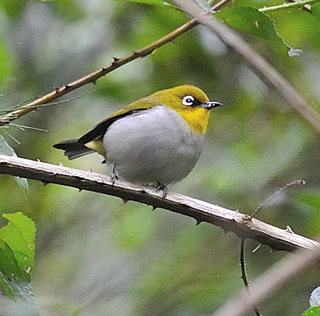
The white-eyes are a family, Zosteropidae, of small passerine birds native to tropical, subtropical and temperate Sub-Saharan Africa, southern and eastern Asia, and Australasia. White-eyes inhabit most tropical islands in the Indian Ocean, the western Pacific Ocean, and the Gulf of Guinea. Discounting some widespread members of the genus Zosterops, most species are endemic to single islands or archipelagos. The silvereye, Zosterops lateralis, naturally colonised New Zealand, where it is known as the "wax-eye" or tauhou ("stranger"), from 1855. The silvereye has also been introduced to the Society Islands in French Polynesia, while the Japanese white-eye has been introduced to Hawaii.

The Indian white-eye, formerly the Oriental white-eye, is a small species of passerine bird in the white-eye family. It is a resident breeder in open woodland on the Indian subcontinent. They forage in small groups, feeding on nectar and small insects. They are easily identified by the distinctive white eye-ring and overall yellowish upperparts. The range previously extended eastwards to Southeast Asia, Indonesia and Malaysia. Their name was recently changed due to previous members of Zosterops palpebrosus in Southeast Asia being renamed to a new species, making the Indian White-eye a more geographically accurate term for this species.

The Sri Lanka white-eye is a small passerine bird in the white-eye family, which is endemic to Sri Lanka. It is a resident breeder in forests, gardens and plantations, mainly in the highlands.

The warbling white-eye is a small passerine bird in the white-eye family. The specific epithet is occasionally written japonica, but this is incorrect due to the gender of the genus. Its native range includes much of East Asia, including the Russian Far East, Japan, Indonesia, Korea, and the Philippines. It has been intentionally introduced to other parts of the world as a pet and as pest control, with mixed results. As one of the native species of the Japanese islands, it has been depicted in Japanese art on numerous occasions, and historically was kept as a cage bird.

The Louisiade white-eye or islet white-eye is a species of bird in the family Zosteropidae. It is endemic to Papua New Guinea, where it is found on widely disjunct islets on both the Bismarck and Louisiade archipelagos.

The Malagasy white-eye is a species of bird in the white-eye family, Zosteropidae. Found in Madagascar and Seychelles, its natural habitats are subtropical or tropical dry forests, subtropical or tropical moist lowland forests, subtropical or tropical mangrove forests, and subtropical or tropical moist montane forests.

The Ethiopian white-eye, formerly known as Heuglin's white-eye or montane white-eye, is a small passerine bird in the white-eye family Zosteropidae. It is found in southeast Sudan, Eritrea and north, central and east Ethiopia. Its natural habitats range from subtropical or tropical moist montane forests, to subtropical or tropical high-altitude shrubland, plantations, and rural gardens.

The northern yellow white-eye, formerly the African yellow white-eye, is a species of bird in the family Zosteropidae. It is found across sub-Saharan Africa, from Senegal in the west across to southern Sudan in the east and south to northern Angola. It was formerly considered to be conspecific with the Angola white-eye.
The Mbulu white-eye is a bird species in the family Zosteropidae. It is found in southern Kenya and northern Tanzania.
The pale white-eye also known as Kenya white-eye is a bird species in the family Zosteropidae. It is found in Kenya, eastern Tanzania, southern Ethiopia and southern Somalia.

The broad-ringed white-eye or Kilimanjaro white-eye is a bird species in the family Zosteropidae. It is found in northeast Tanzania.

Swinhoe's white-eye is a bird species in the white-eye family Zosteropidae. It is found in east China, Taiwan, north Vietnam, the Thai-Malay Peninsula, Sumatra and Borneo. Populations have also been introduced throughout Southern California.

Hume's white-eye is a bird species in the family Zosteropidae. It is found in upland areas of Myanmar, southern Thailand, the Malay Peninsula and Borneo.

The sangkar white-eye is a bird species in the family Zosteropidae. It is also known as the Sunda white-eye. It is found in forested habitats on the Indonesian islands of Java and Bali. In Java it is typically found at elevations between 200–1,600 m (660–5,250 ft), but it sometimes occurs at lower elevations as well.
The Socotra white-eye is a bird species in the family Zosteropidae. It is found on the island of Socotra and in Somaliland.

The Aldabra white-eye is a bird species in the family Zosteropidae. It is endemic to the island of Aldabra in the Indian Ocean.

The southern yellow white-eye is a bird species in the family Zosteropidae. It is found in parts of southern Africa. It was formerly considered conspecific with the African yellow white-eye.

The green white-eye is a bird species in the family Zosteropidae. It is found in Tanzania, Uganda and the Democratic Republic of the Congo.
The Kafa white-eye is a small passerine bird in the white-eye family, Zosteropidae. It is found in west and southwest Ethiopia as well as on Mount Kulal in north Kenya. It was formerly considered to be a subspecies of Ethiopian white-eye.
The Angola white-eye, is a small passerine bird in the white-eye family Zosteropidae. It is found from central Democratic Republic of the Congo to northern and central Angola. It was formerly considered to be conspecific with the northern yellow white-eye.


















